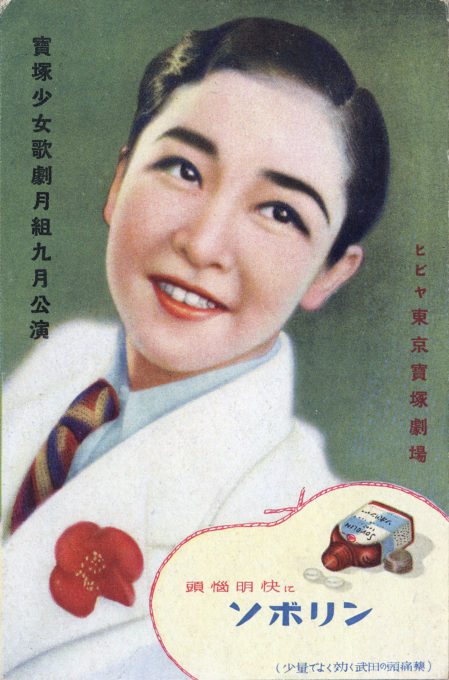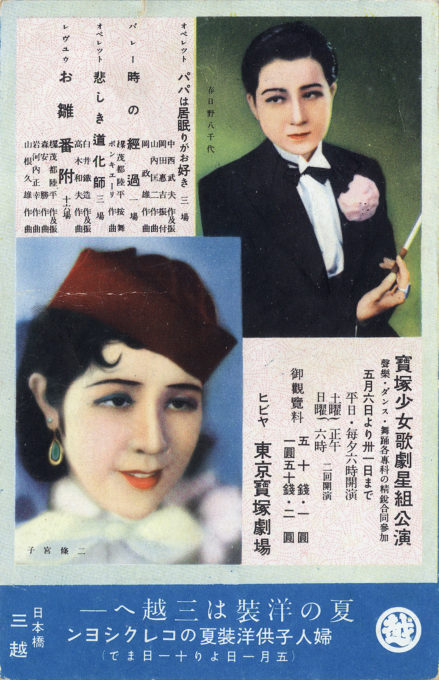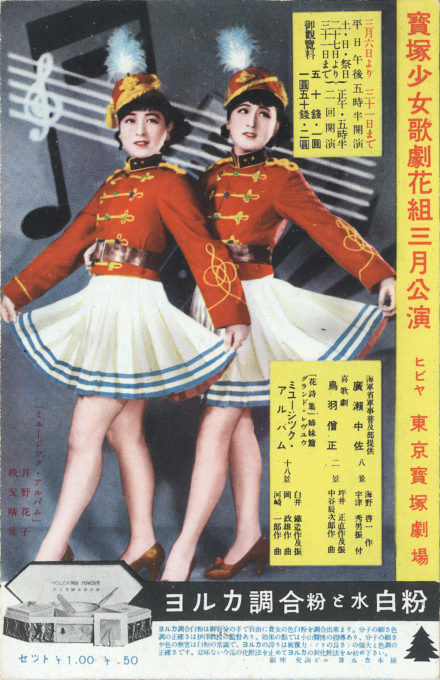
Takarazuka Revue advertising postcard, Tokyo, for the trio of acts performed by the Moon Troupe September 1-28, 1938, at the Hibiya Takarazuka Theater in Tokyo — A Flowered Glacier, Tsunemasa’s Departure for the Front Lines, and The Big Apple revue. ‘Sovolin’ antiseptic medication is advertised. Actor Fukuko Sayo, pictured, performed the lead role of ‘Chuckles’ in The Big Apple.
See also:
Takarazuka Gekijo (Theater), Tokyo
Takarazuka Revue, “Parisette”, c. 1930.
Takarazuka Hotel, Takarazuka Baths & the Takarazuka Grand Theatre, Takarazuka, c. 1920-1930.
Tokyo-Takazaruka Eiga K.K. (Tokyo-Takarazuka Motion Picture Co.) studio, c. 1938.
“The all-female Takarazuka Revue was founded in the hot springs resort of Takarazuka by Kobayashi Ichizo (1873-1957), the Hankyu railroad-and-department store tycoon … and remains one of the most widely recognized and watched of the so-called theaters for the masses (taishu engeki) that were created in the early 20th century.
Takarazuka Revue advertising postcard, Tokyo, for performances by the Star Troupe at the Takarazuka Theatre May 6-May 31, 1936 of Papa Likes Dozing / Sad Clowns / The Passage of Time / Doll Rankings. The Takarazuka engaged Mitsukoshi department store as the main advertising sponsor.
“Takarazuka productions range from Japanese historical dramas, such as the Tale of Genji, to Western musicals, such as Oklahoma. The widespread popularity and social impact of the Revue are evident in the literally hundreds of articles that have been published in a wide range of print media since its founding.
“… The Revue’s actors are called ‘Takarasiennes’ (takarajiennu), after Parisiennes, in recognition of the original influence of the French revue … Upon their successful application to the Takarazuka Music Academy, founded in 1919 as a part of the Revue complex, the student actors are assigned (what I call) their ‘secondary’ genders.
“Unlike ‘primary’ gender, which is assigned at birth on the basis of an infant’s genitalia, secondary gender is based on both physical (but not genital) and sociopsychological criteria: height, physique, facial shape, voice, personality, and, to a certain extent, personal preference.
Takarazuka Revue advertising postcard, Tokyo, for performances at the Tokyo Takarazuka Theatre by the Flower Troupe, March 6-31, 1936, of Commander Hirose / Touba Soup / Music Album.
“Secondary gender attributes or markers are premised on contrastive gender stereotypes themselves; for example, men are supposed to be taller than women; to have a more rectangular face, thicker eyebrows, a higher-bridged nose, darker skin, straighter shoulders, narrower hips, and a lower voice than women; and to exude charisma (kosei
), which is disparaged in women. “… Much of the training of the Revue actors involves learning a vocabulary of gendered gestures, movements, intonations, speech patterns, and the like. An otokoyaku, for example, must stride forthrightly across the stage, her arms held stiffly away from her body, her fingers curled under her thumbs. In contrast, a musumeyaku pivots her forearms from the elbows, which are kept pinned against her side, contraining her freedom of movement and consequently making her appear more ‘feminine’.
“In keeping with the patriarchal values informing the Takarazuka Revue, musumeyaku have represented the fictional Woman with little if any connection to the actual experiences of females. The otokoyaku, however, have been actively encouraged to study the behavior and actions of men offstage (as well as in films) in order to more effectively idealize men on stage, be they samurai or cowboys.”
– “The Politics of Androgyny in Japan: Sexuality and Subversion in the Theater and Beyond”, by Jennifer Robertson, American Ethnologist, Vol. 19 No. 3, August 1992



